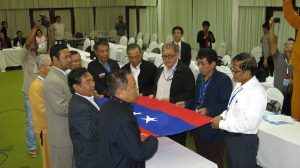The leaders of the Federal Union Army (FUA) held their first meeting on November 28-29, 2014, during which the leaders strongly condemned the Burmese Army’s recent attack on the Kachin Independence Organization (KIO) Military Academy, which resulted in the death of 23 cadets, and injured 20.
The FUA, formed by the United Nationalities Federal Council (UNFC) has been criticized by the Burmese government, the Myanmar Peace Center (MPC), and various Burmese politicians as a threat to Burma’s peace process. In a November 30th interview with the Democratic Voice of Burma (DVB), the MPC’s U Aung Naing Oo said that the FUA is dangerous. Further, Burmese Army Chief General Min Aung Hlaing expressed his refusal to accept the FUA because it would compete with his Burmese Army. The General claimed that in a country, there must be only one army.
In response to such criticisms, Khun Okkar, an advisor to the FUA, stated that the Burmese Army should not worry about the formation of the FUA, as it neither competes with the Burmese Army, nor threatens Burma’s peace process; the group is just preparing to take part in Burma’s future federal army.
In order to understand the purpose of the FUA, one needs to understand why the FUA was formed in the first place. The process of forming the FUA began before the peace process started in Burma. The FUA was formed during the 1st UNFC conference held in February, 2011, to which I was invited. At that time, the Burmese government threatened to attach ethnic armed groups if they did not transform themselves into Border Guard Forces and did not abide by the 2008 Constitution. At this conference, the members of the UNFC decided to form a new coalition force, but in a different structure.
Since the UNFC’s main objective is to form a genuine federal union in Burma, its army should also be formed under a federalist structure, comprised of UNFC member groups and different ethnic groups; the National Democratic Front (NDF) was one such coalition army. Although the name of the group is the Federal Union Army, it does not necessarily mean the FUA is competing with, or taking over, the current Burmese Army. The FUA is just another coalition force of ethnic armed groups, under a different name and structure.
This new coalition force does not threaten the peace process, as the Burmese Army Chief and the MPC believe. If it does, the UNFC would not have continued engaging in peace talks with the Burmese government. Burma’s future federal army should be comprised of not only the FUA, but also all major ethnic groups, including Burman. I don’t think the UNFC would be naïve enough to claim that its armed force is competing with the Burmese Army, nor prepare to replace the current Burmese armed force. The coalition’s sole purpose is to defend its people from the threats of the Burmese Army. If political issues are settled, there would no more of the FUA.
If the Burmese Army and the Burmese government have serious intentions of solving the country’s political problems, or to have peace in Burma, they should start engaging in political dialogues with ethnic armed groups, instead of prolonging the discussion on a nationwide ceasefire agreement. In a recent November 22nd interview with the Voice of America (VOA), General Min Aung Hlaing expressed that the Burmese Army did not want to amend the 2008 Constitution, rather insisting that the ethnic armed groups accept the constitution. The General’s position sent a strong message to the ethnic armed groups and the UNFC that the Burmese Army does not want peace, thus, they have prepared to defend themselves for future armed conflicts. I am surprised to see some MPC scholars criticizing the FUA without any factual analysis of the nature of the conflict in Burma.
Currently, there are no independent mediators, international monitoring teams, nor any international peacekeepers involved in Burma’s peace process. The peace process is mediated by the Burmese government; the Burmese government is both the fighter and referee in the process. If fighting occurs between the Burmese Army and an ethnic armed group, there are no independent teams to investigate the incident. The Burmese Army’s recent attack on the KIO Military Academy stands as a classic case. After the attack, there was no independent body which could investigate and mediate the incident. Instead, each side blamed each other and increased security to deter future attacks.
With no independent peacekeepers to provide security during the peace process, all parties involved in the conflict are relying on self-help for their security. In doing so, it will lead to a security dilemma, in which a group or state tries to increase its security by expanding its military strength, which leads to a threat to the security of other groups or states. In response, the other groups increase securities by forming an alliance. For example, if the Burmese Army increases its security by expanding its military in ethnic areas, ethnic armed groups see that action as a threat to their security and respond by forming coalitions in order to provide security for their members.

IMNA Editor; Pon Nya Mon is a Research fellow at the Salween Institute (www.salweeninstitute.org). He can be reached atpnmon2008@gmail.com-
